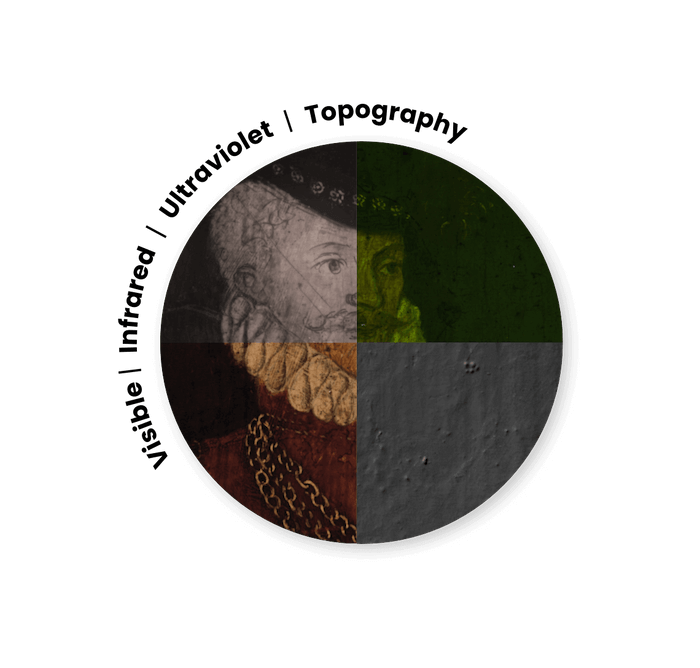Visible light
Accurate color representation
Ultraviolet
Reveal restorations, defects and techniques
Near-infrared
View sublayer compositions
Topography
Reveal the texture of the work

Interactive multi-spectral exploration
Thanks to the unique tool "split view", developed by Artmyn, analyse any detail under different lights in one glance.
Discover restorations, sketches, repentances and preparatory drawings.

A powerful tool for experts and enthusiasts alike
Allow experts, committees, curators or restorers to explore the work on a screen, to move and tilt it as if they had it in their own hands, even from a distance.
Also allows to compare very precisely different paintings from the same artist.

Visible light
Visible light corresponds to the spectrum sensitive to the human eyes, i.e from 380nm to 750nm, and which covers all the colors.
Under grazing light the texture and smallest details of the artwork are revealed.

Ultraviolet
Ultraviolet fluorescence corresponds to the visible light that is emitted by the object when illuminated with non-visible ultraviolet light at 365nm (a.k.a. black light).
Dark areas represent regions painted after the rest of the work.
This view is very useful to assess surface condition of an artwork (restoration, hidden damages, etc).
With ultraviolet light, some areas appear quite dark in contrast to the fluorescent areas. These are usually areas painted after the rest of the work.
Ultraviolet light is essential for assessing the condition and age of artworks. When restoring, buying, selling, exhibiting or appraising, it can detect previous restorations, hidden or concealed damage, alterations such as overpainting, repairs and floating signatures that are normally invisible in daylight.

Near Infrared
Near Infrared corresponds to the invisible light between 920nm to 1200nm.
This view allows to "see through" paint layers that are impenetrable to the human eye.
This is a non-invasive to reveal preparatory drawing, sketches, pentimenti, damages, retouching or even another painting.
Carbon black, for example, is very absorbent to infrared radiation. Therefore, if an artist has started a painting by drawing the pattern in black on a white background (a so-called underdrawing), an infrared image can make it visible.

Topogaphic view
The topographic view is not extracted from a spectral band but rather from a group of light orientations. It produces a shading based only on the topography of the surface to give a good impression of the 3D of the surface of the work.
This view reveals the texture and the materiality of the work.

